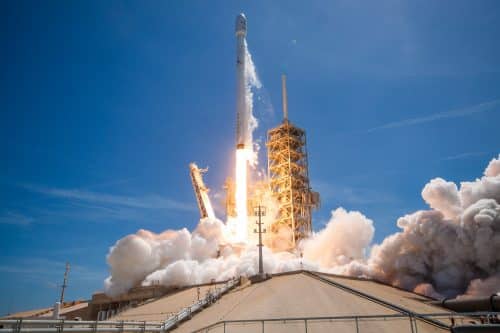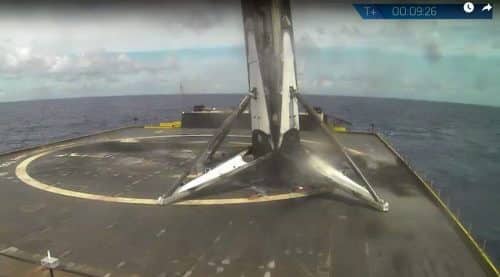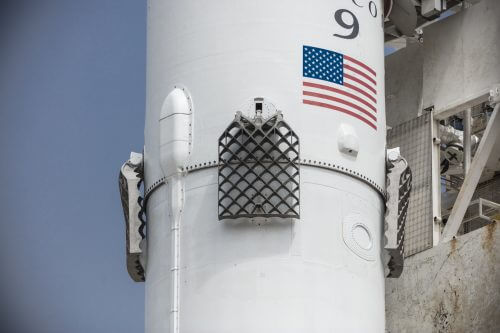SpaceX continues to push the boundaries of the space launch industry, this time launching two Falcon 9 launchers just two days apart. The first of these was also the company's second used launcher. The first two stages of the launchers were successfully landed on mobile platforms at sea, which will allow them to be reused.

SpaceX launched a Falcon 9 rocket yesterday (Sunday), carrying 10 Iridium communication satellites. The launch was carried out only two days after another Falcon 9 launch, last Friday, in which a BulgariaSat communications satellite was launched into space. Both launches were carried out successfully, and in both the company managed to land the first and main stage of the launcher on a mobile rig in the middle of the sea.
The adjacent launches were made possible thanks to the two separate launch sites owned by SpaceX. Friday's launch was conducted from the Kennedy Space Center in Florida, while yesterday's launch was conducted from Vandenberg Air Force Base in California.
The company has another launch site at the Cape Canaveral Spaceport in Florida, which is adjacent to the Kennedy Space Center, but it has been down since it was damaged in the explosion last year, which resulted in the destruction of the Israeli satellite Amos 6. The site is currently undergoing renovation, and is expected to return to activity this year. The company is also building these days Fourth launch site in Texas.
Watch a fast motion of the Falcon 9 landing on an offshore rig yesterday:
Sped up version of today's rocket landing on the Droneship Just Read the Instructions (guess it did)
A post shared by Elon Musk (@elonmusk) on
Second launch of a used launcher
In the first of the series of launches, held on Friday, SpaceX used for the second time in its history a partially used rocket - one that uses a recycled first stage of the Falcon 9. The launcher, which is 70 meters high, is built in two stages, with the main and most expensive of them being the first stage.
The used first stage did its first mission in January this year. As then, this time too he landed on a mobile marine rig. The landing was carried out successfully even though the founder and CEO of the company, Elon Musk, warned in advance that there was a high chance that the landing would fail, because "the Falcon 9 will experience its highest [atmospheric] penetration forces and heat ever", according to the tweet of Musk on his Twitter account. As mentioned, the landing was successful, although the launcher landed right at the end of the rig. Musk A message that he is "extra-hard and hit the rig heavily", but that apart from that he is fine.

The first time That SpaceX launched a Falcon 9 with a used first stage was held last March SpaceX intends to continue to carry out additional launches of used Falcon 9 rockets, thereby significantly reducing launch costs. the company Use In two first stages used in the first test flight of its future and more powerful launcher, Heavy falcon, which is planned to be carried out later this year.
Musk noted that the company will even try to land the upper and smaller stage of the launcher in the future. This is an extremely difficult task because the second stage reaches a much higher speed than the first stage, and actually enters orbit around the Earth together with the launched payload. If the space company manages to realize this ambitious goal as well, then its launchers will become completely multi-purpose.
The new titanium fins of the Falcon

As if all the successes described above were not enough, in the second launch, which was held as mentioned yesterday, SpaceX used a new version of the aerodynamic grid fins (grid fins) of the Falcon 9. The fins are placed above the first stage of the launcher, and during the landing on the ground they unfold and allow the missile to steer itself and make a landing accurate
The aerodynamic fins that SpaceX has used so far were made of aluminum with an additional layer for thermal protection, but they were damaged by the high temperatures generated during atmospheric entry and landing, preventing their reuse. To solve this problem, the company this time produced the fins from titanium, which is able to survive the high temperatures.
Although the new fins are heavier than their predecessors, they will have an additional advantage beyond the ability to be reused. According to a report on the NASA Spaceflight website, the fins are larger than their predecessors, and will be able to provide more lift for the launcher during landing. The new fins will thereby improve its buoyancy, which will reduce the amount of fuel required for the rocket combustion of the landing.

6 תגובות
To Elisef and Liriv: Inaccurate. This satellite was the lightest satellite they built for such an orbit. They can launch satellites up to ~5350 kilos into such an orbit in the current configuration. In this launch they put the satellite in a supersynchronous orbit. In this orbit the highest point is much higher than the final orbit, but this way the satellite has to use a smaller amount of fuel to reach the final orbit (it can save ~300 m/s), and its life is extended.
Maybe an opponent can check
Elisaf, thanks for the answer.
To the opponent:
Musk did not specifically mention it, but we can guess that the reason for this is the weight of the cargo and the profile of the orbit to which it is launched.
The BulgariaSat 1 satellite weighs about 3,700 kg, and is a satellite in a geostationary orbit, meaning that it circles the Earth at a distance of about 35,000 km, in an orbit that is coordinated with the self-rotation of the Earth and allows it to always remain above the same point.
The launch itself was to a temporary transfer orbit (Geostationary transfer orbit), from which the satellite moves independently and gradually to its permanent orbit. In such cases the launcher is required to work "overtime" and bring the payload to a higher speed. This leaves less fuel for the landing rocket combustors, which make use of the little fuel left after launch.
On heavier geostationary satellites SpaceX completely gives up on trying to return the first stage, consuming all the fuel during launch.
"The landing was carried out successfully even though the founder and CEO of the company, Elon Musk, warned in advance that there is a high chance that the landing will fail, because the Falcon 9 will experience its highest [atmospheric] penetration forces and heat ever"
How was this landing different from previous landings where the loads were so large?
What is the profit in terms of costs and is there no significant reduction in the weight that the missile can carry to the target?
After all, a lot of extra weight was added to the rocket because of the extra fuel needed to land it again and the extra design to ensure a repeat landing (which both increase costs and weight).
What's more, the durability of the multiple launch structure has not yet been tested, so safety is not yet guaranteed.